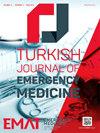E-HEART score: A novel scoring system for undifferentiated chest pain in the emergency department
IF 2.3
Q3 EMERGENCY MEDICINE
引用次数: 0
Abstract
OBJECTIVE: Cardiovascular disease is the leading cause of death worldwide. As there is an increase in the global burden of ischemic heart disease, there are multiple scoring systems established in the emergency department (ED) to risk stratify and manage acute coronary syndrome (ACS) in patients with chest pain. The objective of this study was to integrate point-of-care echo into the existing history, electrocardiogram, age, risk factors, and troponin (HEART) score and evaluate a novel scoring system, the echo HEART (E-HEART) score in risk stratification of patients presenting with undifferentiated chest pain to the ED. The E-HEART Score was also compared with existing traditional scoring systems for risk-stratifying acute chest pain. METHODS: A diagnostic accuracy study involving 250 patients with chest pain at the ED of a single tertiary care teaching hospital in India was conducted. The emergency physicians assessed the E-HEART score after integrating their point-of-care echo/focused echo findings into the conventional HEART score on presentation. The primary endpoint was the occurrence of major adverse cardiovascular events (MACE) within 4 weeks of initial presentation. The accuracy of the E-HEART score was compared with other conventional risk stratification scoring systems such as the thrombolysis in myocardial infarction (TIMI), history, electrocardiogram, age, and risk factors, Troponin Only Manchester ACS (T-MACS), and HEART scores. RESULTS: A total of 250 patients with a median age of 53 years (42.25–63.00) were part of the study. Low E-HEART scores (values 0–3) were calculated in 121 patients with no occurrence of MACE in this category. Eighty-one patients with moderate E-HEART scores (4–6) were found to have 30.9% MACE. In 48 patients with high E-HEART scores (values 7–11), MACE occurred in 97.9%. The area under receiver operating characteristics (AUROC) of E-HEART score is 0.992 (95% confidence interval: 0.98–0.99), which is significantly higher than AUROC values for HEART (0.978), TIMI (0.889), T-MACS (0.959), and HEAR (0.861), respectively (P < 0.0001). At a cutoff of E-HEART score >6, it accurately predicted ACS with a sensitivity of 92% and a specificity of 99% with a diagnostic accuracy of 97%. CONCLUSION: The E-HEART score gives the clinician a quick and accurate forecast of outcomes in undifferentiated chest pain presenting to the ED. Low E-HEART scores (0–3) have an extremely low probability for short-term MACE and may aid in faster disposition from the ED. The elevated risk of MACE in patients with high E-HEART scores (7–11) may facilitate more aggressive workup measures and avoid disposition errors. E-HEART is an easily adaptable scoring system with improved accuracy compared to conventional scoring systems.E-HEART评分:一种用于急诊科无差别胸痛的新型评分系统
本文章由计算机程序翻译,如有差异,请以英文原文为准。
求助全文
约1分钟内获得全文
求助全文
来源期刊

Turkish Journal of Emergency Medicine
EMERGENCY MEDICINE-
CiteScore
1.70
自引率
0.00%
发文量
30
审稿时长
22 weeks
期刊介绍:
The Turkish Journal of Emergency Medicine (Turk J Emerg Med) is an International, peer-reviewed, open-access journal that publishes clinical and experimental trials, case reports, invited reviews, case images, letters to the Editor, and interesting research conducted in all fields of Emergency Medicine. The Journal is the official scientific publication of the Emergency Medicine Association of Turkey (EMAT) and is printed four times a year, in January, April, July and October. The language of the journal is English. The Journal is based on independent and unbiased double-blinded peer-reviewed principles. Only unpublished papers that are not under review for publication elsewhere can be submitted. The authors are responsible for the scientific content of the material to be published. The Turkish Journal of Emergency Medicine reserves the right to request any research materials on which the paper is based. The Editorial Board of the Turkish Journal of Emergency Medicine and the Publisher adheres to the principles of the International Council of Medical Journal Editors, the World Association of Medical Editors, the Council of Science Editors, the Committee on Publication Ethics, the US National Library of Medicine, the US Office of Research Integrity, the European Association of Science Editors, and the International Society of Managing and Technical Editors.
 求助内容:
求助内容: 应助结果提醒方式:
应助结果提醒方式:


